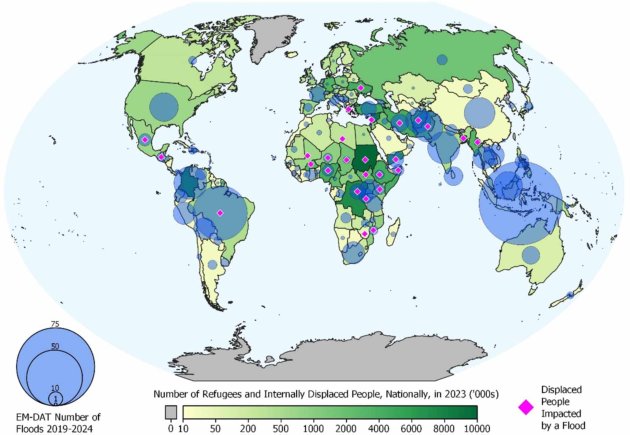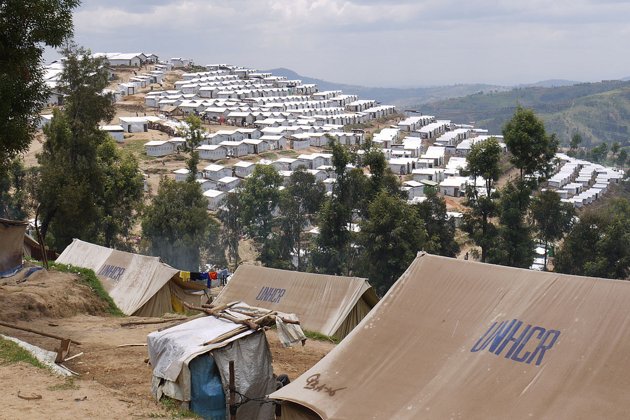Disaster Risk
12 challenges in protecting displaced people from flood risk
7 min
Recent research sought to identify the main challenges in reducing the risk and impact of floodings on displaced people.
In countries and regions where refugees and internally displaced persons (IDPs) are living in camps and settlements, decision-makers in charge of flood management are faced with multiple challenges which are often overlooked.
Conflict, climate change, natural disasters and other calamities may cause people to flee their homes – even countries – and settle elsewhere. Unfortunately, these forcibly displaced persons often end up in locations and situations where they still aren’t safe.
According to the UNHCR Global Trends Report, in 2024, there were an estimated 123.2 million displaced people (or 1 in 67 of the global population), living under precarious circumstances. 75% of them were hosted in countries with limited resources to help them. The number of forcibly displaced people has also doubled in the past decade.
One of the most frequent hazards facing already forcibly displaced people is flooding. From 2019 to 2024, 40 major flood impacts on already displaced people were reported across 27 countries. The true number is probably even higher, since flood events tend to be poorly reported.
More effective flood management could certainly contribute to alleviating the pressure. However, in everyday practice, this is harder than it seems.

Map of displaced persons per country, overlaid with flood events reported between 2019 and 2024. Pink diamonds represent locations where displaced people have been affected by flooding. Image: Hawker et al. (2024)
Recent research sought to identify the main challenges in reducing the risk and impact of flooding on displaced people. The research combined literature, interviews with staff in refugee camps in East Africa, and the outcomes of the 2023 Global Flood Partnership meeting, which involved 23 researchers and practitioners.
Humanitarian crises require quick decisions to ensure human safety. This means there is simply no time or resource to undertake a rigorous flood risk study of a refugee/IDP receiving location.
To make matters worse, flood data tend to arrive too late, and assessing its relevance takes more time than the circumstances allow.
Host communities are often themselves vulnerable, so they must be considered in flood management strategies. Additionally, host communities have critical prior knowledge of floods.
Refugee camps are often placed in remote, high-risk areas where access to livelihoods is limited and basic services are given priority over flood risk. As a result, flood management is often put in place only after camps have already been established.
Displacement is often seen as temporary, but in reality, it usually lasts for many years (average 10.3 years). Consequently, investments in infrastructure and flood mitigation in camps and settlements are insufficient as it is assumed these areas would exist for a short time period.
Services for displaced people are managed by many actors, including governments, organisations, host communities, and the displaced people themselves. Effective collaboration between all these actors can be difficult to navigate.
Existing handbooks don’t contain explicit instructions on conducting flood risk assessments or using specific datasets. As a result, decisions are left to planners on-site.

A refugee camp in Southern Rwanda. Oxfam East Africa, CC BY 2.0, via Wikimedia Commons
Humanitarian workers often handle multiple tasks at once, with disease control after floods taking up much of their time. Because of this, flood risk assessments that could prevent future health concerns are rarely included in broader planning.
Confusion over guidelines and responsibilities leads to unclear decision-making in flood management.
This situation is made worse by the fact that decisions tend to be made at the coordinating level, with no single person being responsible.
With the best intentions, too much data is supplied by too many parties, which makes it hard for decision-makers to make sense of it all. Data can only be useful to flood risk management with strong governance and clear procedures.
Besides the sometimes overwhelming abundance of it, the data supplied isn’t always fit for purpose.
Limitations in data should be clearly communicated to decision makers at the very early stages of stakeholder engagement.
Displaced people may not be ready to move in the face of flood warnings because they’re afraid they might lose their place and belongings, especially after an often traumatic upheaval in their lives.
Another concern is being separated from family and loved ones during evacuation and relocation.
Flood management efforts are often hindered by a lack of funding, time, and trained humanitarian workers. This causes delays of important improvements such as drainage, stronger defences and safer infrastructure.
With the recent defunding of development aid, these issues are increasingly pertinent, as recently highlighted by the UNHCR in their Global Trends Report, describing the humanitarian system at a breaking point.
The authors conclude with a list of recommendations to address these challenges.
Among the highlights is the suggestion that flood management should start from reliable existing data, taking into account multiple hazards in order to be truly effective.
Also, programmes should work towards long-term sustainable solutions, and decisions should be inclusive, aimed at empowering displaced people as well as host communities.
Clear documentation and guidelines will contribute to targeted decision-making, especially where local knowledge is integrated into the process.
Finally, in terms of ethics, the authors stress the responsibility of science, calling for a renewed code of ethics. Scientists must recognise their influence on the lives of vulnerable populations and ensure that risks and benefits are clearly communicated.
This story is an adaptation of a published journal article: Hawker, L., Trigg, M. A., Kruczkiewicz, A., Bernhofen, M., Katsi, L., Paterson, R., ... & Balfour, N. (2024). Data, guidelines and ethics for managing flood risk when people are already forcibly displaced. Environmental Research Letters, 20(1), 011001.
It has been adapted with permission from the authors and in accordance with the copyright license CC BY 4.0
To read the original paper, follow the link below: